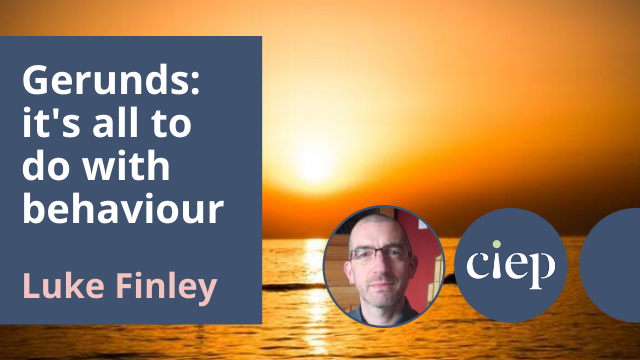Gerunds can be tricky beasts. But Luke Finley has got the measure of them, and guides us through some of their uses.
 The gerund is a verb in its -ing form that is functioning like or as a noun. Distinguishing between the gerund and the present participle – also the verb in its -ing form – is not always easy, but generally it can be regarded as a gerund if it’s behaving more like a noun, and as a present participle if it’s behaving more like an adjective. Recognising the ambiguities of this in practice, modern grammars tend not to categorise them separately: Huddleston and Pullum’s Cambridge Grammar talks about the ‘gerund-participle’.
The gerund is a verb in its -ing form that is functioning like or as a noun. Distinguishing between the gerund and the present participle – also the verb in its -ing form – is not always easy, but generally it can be regarded as a gerund if it’s behaving more like a noun, and as a present participle if it’s behaving more like an adjective. Recognising the ambiguities of this in practice, modern grammars tend not to categorise them separately: Huddleston and Pullum’s Cambridge Grammar talks about the ‘gerund-participle’.
Clear-cut uses
In some positions, it’s quite clear that the -ing form is functioning as a gerund. For example, where it’s used as the subject or object (or part of it):
Writing a sample sentence will clarify this
I’m trying to communicate this in writing
Sometimes a modifying adjective will make the noun function of the gerund clearer:
Poor-quality writing won’t help
The explanation won’t be clear if the writing is of poor quality
In other situations the gerund may be harder to identify:
My deftly explaining this aspect of grammar will help many thousands of people
The -ing word here is modified by an adverb: definitely verb-like rather than noun-like behaviour. But it’s still part of the noun phrase, so it’s a gerund.
Another common use of gerunds is in forming compound nouns:
In my free time I enjoy water-skiing, base-jumping and free-ironing*
*Some artistic licence has been employed in this sentence.
This process seems especially popular in the world of corporate jargon: brainstorming, streamlining, upscaling, and so on.
Because of the gerund’s dual properties of noun and verb, new verbs are often then back-formed from these compound nouns; to crowdsource might be the kind of neologism some people love to hate, but it’s a good demonstration of the elasticity of language.
Trickier uses
One trickier aspect of usage is deciding between the gerund and the to-infinitive to follow a verb. Sometimes only one or the other is possible. In other cases either is possible but the meaning may be subtly different. This can often trip up English learners, even those who are quite fluent. No doubt this is because there isn’t a hard-and-fast rule: it depends on what the preceding verb is. If you speak English as a first language you tend to pick the right one by instinct, without even being aware that you’re making a decision; learners of English have to try to memorise lists of what goes with what. In the following examples only the gerund works:
I enjoy running by the sea
I can’t imagine swimming in it
 With different verbs – even though the meanings are not that distant from the first versions – the gerund would not work and only the infinitival form will do:
With different verbs – even though the meanings are not that distant from the first versions – the gerund would not work and only the infinitival form will do:
I want to run by the sea
I don’t need to swim in it
The verb like can work either way, but with slight nuances of meaning. With the gerund, the enjoyment of the activity itself is emphasised. With the to-infinitive, there is greater emphasis on the regularity or repeated nature of it:
I like running on Sundays, but sometimes I have to do the ironing instead
I like to run on Sundays, but I only like to swim in the summer
This choice between the gerund and the infinitival form doesn’t occur only after verbs. And in some cases it’s a difficult call. You might see a formulation like the following sentence in a relatively formal text:
We conducted this survey with the aim to understand gender variations in …
Is this wrong? It sounds stilted, but it’s not necessarily grammatically incorrect. In a proofread you might judge it just about acceptable and leave it, but in a copy-edit I think you’d be likely to change it to the more natural-sounding gerund: the aim of understanding.
![]() Luke Finley is an Advanced Professional Member, and set up Luke Finley Editorial in 2013. He will edit just about anything, but specialises in social policy and politics.
Luke Finley is an Advanced Professional Member, and set up Luke Finley Editorial in 2013. He will edit just about anything, but specialises in social policy and politics.
This article originally appeared in the January/February 2018 edition of Editing Matters.
Photo credits: Water-skiing by Tobia Sola, Running by the sea by Hamish Duncan on Unsplash
Posted by Abi Saffrey, CIEP blog coordinator.
The views expressed here do not necessarily reflect those of the CIEP.
